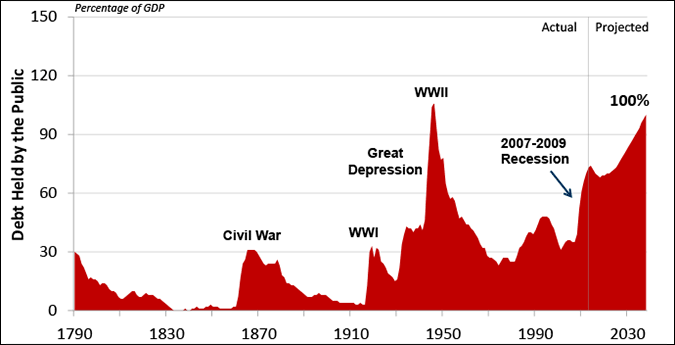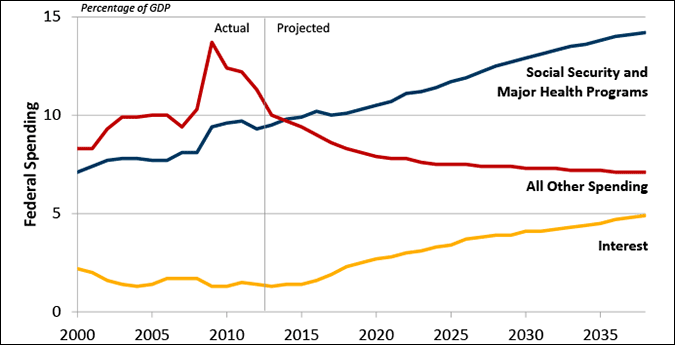U.S. debt is on an unsustainable path if current laws remain unchanged
In its 2013 Long-Term Budget Outlook, the Congressional Budget Office (CBO) issued a warning that the national debt is near an all-time high and will grow to unsustainable levels. Currently, the federal debt is about 73 percent of GDP. CBO projects that debt will climb to 100 percent of GDP within 25 years. This assumes, however, that current law will not be changed and discretionary spending will decline to historically low levels. Under more pessimistic assumptions, debt could grow to 190 percent of GDP by 2038.
Under an alternative fiscal scenario, debt is projected to reach 190% of GDP in 2038
SOURCE: Data from the Congressional Budget Office, The 2013 Long-Term Budget Outlook, September 2013. Compiled by PGPF.
NOTE: The projection includes the effects of higher levels of debt on the economy. The data provided by CBO begins in 2018.
The principal driver of long-term debt is a fundamental mismatch between our growing spending for Social Security and major health care programs and a tax system that does not generate enough revenue to cover those costs. The effects of this fiscal mismatch on deficits and debt are compounded by rising interest costs that worsen as the debt grows.
Rising long-term debt risks damaging our economy. CBO warns that:
“The high and rising amounts of federal debt held by the public that CBO projects for coming decades under the extended baseline would have significant negative consequences for both the economy and the federal budget. Those consequences include reducing the total amounts of national saving and income; increasing the government’s interest payments, thereby putting more pressure on the rest of the budget; limiting lawmakers’ flexibility to respond to unexpected events; and increasing the likelihood of a fiscal crisis.”
In order to maintain the debt-to-GDP ratio at its current level of around 70 percent in 2038, CBO estimates that Congress would need to generate $2 trillion in savings over the next decade. To bring debt back down to the historic level (around 40 percent of GDP) in 2038, we would need $4 trillion in savings over the next decade.
Under current law, federal debt is projected to be about twice as large as was projected last year. The primary cause of this difference is the recent tax legislation that permanently extended the 2001/2003/2009 tax cuts for most taxpayers, and indexed the Alternative Minimum Tax for inflation.
ENTITLEMENT SPENDING IS GROWING
Spending for Social Security, Medicare and Medicaid is growing and will continue to climb in the long-term.
SOURCE: Data from the Congressional Budget Office, The 2013 Long-Term Budget Outlook, September 2013. Compiled by PGPF.
NOTE: Projections are from CBO’s Extended Baseline.
Chosen excerpts by Job Market Monitor. Read the whole story at





Reblogged this on This Got My Attention and commented:
Too many want to ignore the facts of life.
Posted by Mike | October 18, 2013, 9:47 amReblogged this on euzicasa and commented:
And yet there is no temperance in oversight!
Posted by george-b | October 18, 2013, 3:05 pmI wonder how much is given as corporate welfare as opposed to “poor” people and social security “welfare”.
Posted by Carl D'Agostino | October 18, 2013, 3:40 pm